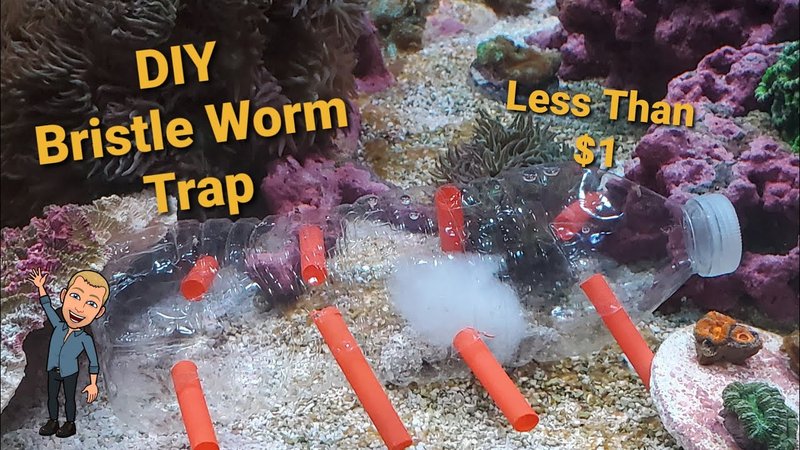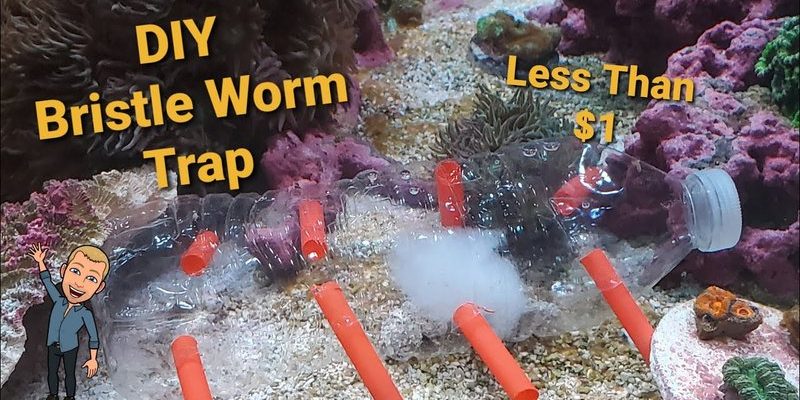
Creating your own traps to remove bristle worms is not just a smart way to manage your aquarium; it can also be an enjoyable project. You don’t need to be a marine biologist or an engineering wizard to whip up a few traps. With simple materials you likely have lying around the house, you can safely and effectively reduce their numbers. Let me walk you through some methods that are not only easy but also environmentally friendly.
Understanding Bristle Worms
Before diving into trap-making, it’s essential to understand what bristle worms are and why they might be in your aquarium. These worms belong to the class Polychaeta and are often found in marine environments. They can vary in size and color, typically exhibiting bristles that can irritate your skin if handled. Now, you might be asking yourself, “Why should I care?” Well, while bristle worms can help with cleaning up waste, they can also outgrow their welcome. If left unchecked, they can overwhelm your tank, leading to poor water quality and stressed fish.
To put it simply, bristle worms are like the uninvited guests at a party: they might help clean up after the festivities, but when they start multiplying, they can ruin the fun for everyone else. Therefore, managing their population is crucial for maintaining a healthy aquarium.
Why DIY Traps Are Effective
DIY traps are a fantastic way to manage bristle worms for several reasons. First off, they are safe and minimize chemical usage in your tank. This is crucial because chemicals can harm your fish and corals, disrupting the entire ecosystem you’ve built.
Moreover, creating your own traps can save you money compared to purchasing commercial products. Often, those ready-made traps can be pricey and might not even be as effective as a simple DIY solution. Plus, making traps lets you have full control over what goes in and out of your aquarium, ensuring a gentle approach to pest removal.
Trap Types
There are various types of traps you can create, so here are a few popular methods:
- Jar Trap: Using a simple glass or plastic jar can be remarkably effective.
- Bucket Trap: A bucket filled with bait can attract bristle worms.
- DIY Bottle Trap: An old soda bottle can be transformed into a bait-holding trap.
Each has its advantages, depending on your aquarium size and how many bristle worms you suspect are lurking around.
How to Make a Jar Trap
Let’s start with the jar trap, which is perhaps the easiest method. Here’s how you can create it:
1. **Gather Materials:** You’ll need a clean jar with a wide mouth, some fish food or other types of bait, and a piece of string or fishing line.
2. **Setup the Trap:** Fill the jar with water and add some bait. You can use a small piece of shrimp or fish food; bristle worms are scavengers and won’t resist that temptation!
3. **Position the Jar:** Place the jar at the bottom of your tank, and ensure that it’s stable. If it floats, you can use the string to tie it to a rock or decor piece.
4. **Check Regularly:** Leave the jar in place for a few hours or overnight, then check for any captured worms. Remove them carefully, and repeat as necessary.
The beauty of this method lies in its simplicity. It’s like setting a fishy dinner party just for the worms!
Building a Bucket Trap
If you’re dealing with a larger infestation, a bucket trap might work better for you. Here’s how to set it up:
1. **Choose Your Bucket:** Select a bucket that you don’t mind submerging in your aquarium. It should be deep enough to prevent the worms from escaping.
2. **Add Bait and Water:** Fill the bucket halfway with water and add a sizeable piece of bait, like fish scraps or a slice of clam.
3. **Create an Entrance:** Cut a hole in the side of the bucket near the bottom. This will allow the worms to crawl in for the bait but prevent them from escaping.
4. **Place and Wait:** Submerge the bucket in your tank, ensuring that the hole is positioned below the waterline. Leave it overnight and check in the morning.
This method works great because it gives worms ample space to meander in, and the bait acts as an irresistible lure!
Going High-Tech: DIY Bottle Trap
If you’re the crafty type, you might enjoy making a bottle trap. Here’s how to do it:
1. **Grab an Empty Plastic Bottle:** Use a 2-liter soda bottle or something similar.
2. **Modify the Bottle:** Cut the upper section off and invert it into the bottom part. This creates a funnel-like entrance.
3. **Add Bait:** Fill the bottom part with water and some bait.
4. **Secure It:** Ensure that the bottle doesn’t float; you can weigh it down with small rocks or sand.
5. **Place in Tank:** Set it at the bottom of your aquarium and let it do the job. Like the jar trap, this will attract bristle worms and keep them contained.
This trap is a creative take and can be quite effective for those who want to experiment a bit.
Best Baits for Traps
No trap is complete without the right bait. Bristle worms love:
- Fish Food: Any type will do, but high-protein options work best.
- Shrimp or Fish Scraps: These are excellent because they smell and taste good to bristle worms.
- Clam or Shellfish Bits: If you have leftover clam or oysters, bristle worms will find this irresistible.
Choosing high-quality bait makes a big difference! Remember, however, using too much can pollute your tank. A small amount is usually sufficient.
Maintaining Your Aquarium After Trap Removal
After you’ve removed some bristle worms using traps, it’s crucial to keep the population under control. Here are some tips:
1. **Regular Feeding Schedule:** Avoid overfeeding your fish, as leftover food can attract bristle worms.
2. **Clean the Tank:** Regularly clean your tank and remove any waste materials. This minimizes the food source available for bristle worms.
3. **Introduce Competing Species:** Some fish, like wrasses, will naturally eat bristle worms. Adding them to your tank can help keep bristle worm numbers in check.
By being proactive about maintenance, you’ll reduce the odds of bristle worms becoming a problem again.
Final Thoughts on DIY Traps
Using DIY traps to remove bristle worms is not only a cost-effective approach; it’s also a safe way to protect your aquarium ecosystem. Whether you go for the jar method, bucket trap, or bottle trap, what matters is the commitment to keeping your aquarium healthy and vibrant.
Remember, patience is key during this process. You might not catch every worm on the first try, but with a bit of persistence and the right setup, those pesky bristle worms won’t stand a chance. So grab your materials, roll up your sleeves, and enjoy the process. Good luck, and happy trapping!

